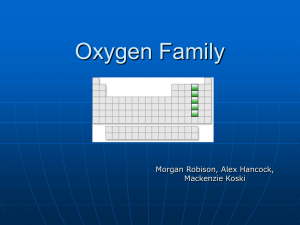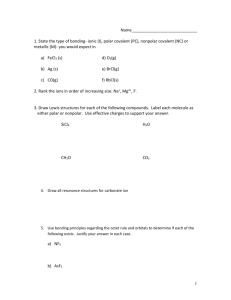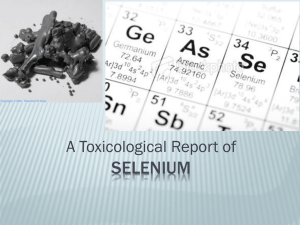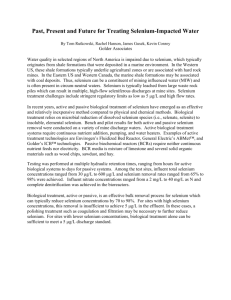Document 13518709
advertisement
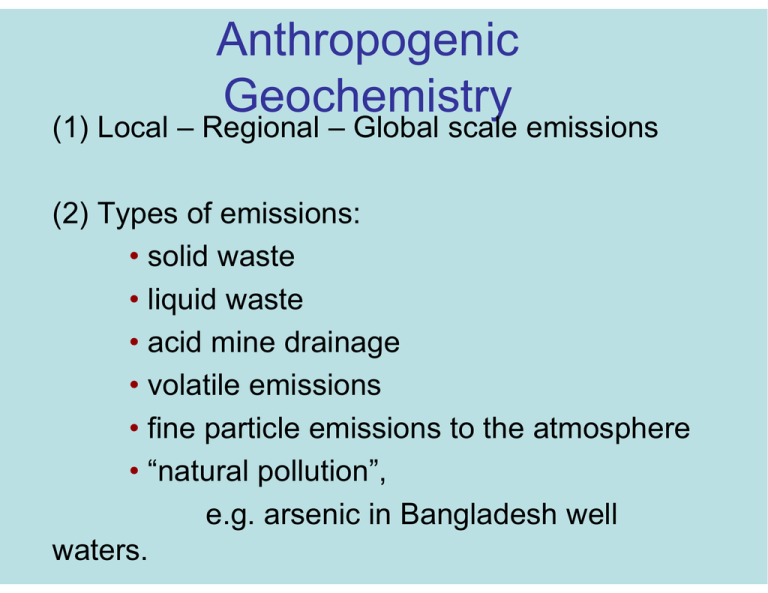
Anthropogenic Geoch hemiistry t (1) Local – Regional – Global scale emissions ((2)) Types yp of emissions: • solid waste • liquid waste waste • acid mine drainage • volatile emissions phere • fine particle emissions to the atmosp • “natural pollution”, e g arsenic in Bangladesh well e.g. waters. Anthropogenic geochemistry 3) Regional and global scale anthropogenic emissions. some elements of particular interest: • Lead (Pb): globally globally, the most anthropogenically enhanced element; emitted to the atmosphere by high temp perature industrial p processes (smelting, g, coal combustion, etc.) and by automobiles using leaded gasoline. • Mercury (Hg): one of the most volatile toxic elements; emitted from high temperature industrial activities (similar to lead); exists in toxic organic mercury compounds Also used in industrial processing and gold compounds. mining, released into natural waters. Mercury is high in fish in lakes located downwind of coal combustion regions. It bioaccumulates in predatory fish such as salmon and swordfish. Anthropogenic geochemistry Hg, g, continued: “Minamata Bayy Disease” from industrial mercury y release into a fished harbor is one of the most infamous pollution episodes. Minamata is a small town in Japan facing an ocean embayment embayment. From 1932 to 1968 1968, a company dumped approximately 27 tons of mercury compounds into the bay. p who ate fish from the bay y develop ped Thousands of people symptoms of methyl mercury poisoning. • Cadmium (Cd): also volatile and used in industrial activities (Ni-Cd batteries; Cd-plated metals, etc.). “Itai-Itai” disease is perhaps the second most infamous pollution episodes. In the early years of the 20th century, villagers along the Jinzu River basin in Japan developed a painful disease that was dubbed “Itai-Itai” (“it hurts, it hurts”)). Research didn’t begin until the 1950s when and in May 1968 it was determined that it was due to chronic cadmium poisoning caused by commercial mining operations. It impairs kidney function and leads to calcium deficiency and brittle bones. Cd in toys Toxic o c metal eta found ou d in kids' ds je jewelry e y very e y dangerous da ge ous By JUSTIN PRITCHARD The Associated Press Sunday, y, Januaryy 10,, 2010;; 2:26 PM -- Cadmium is a soft, whitish metal that occurs naturally in soil. It's perhaps best known as one half of rechargeable nickel-cadmium batteries, but also is used in pigments, electroplating and plastic. Lab testing organized by The Associated Press shows that it also is present in children's jewelry - sometimes at eye­ poppiing levels l exceedi ding 90 percentt off th the ititem''s ttotal t l weight. i ht Most people get a microscopic dose of the heavy metal just by breathing and eating. Plants, including tobacco, take up cadmium through their roots and people absorb it during digestion or inhalation. Without direct exposure, however, people usually don't experience its nasty side: cancer, kidneys that leak vital protein, bones that spontaneously snap. C d i Cadmium iis particularly ti l l d dangerous ffor children hild b because growing i b bodies di readily dil absorb b b substances, b t and d cadmium d i accumulates in the kidneys for decades. "Just small amounts of chemicals may radically alter development," said Dr. Robert O. Wright, a professor at Harvard University's medical school and school of public health. "I can't even fathom why anyone would allow for even a small amount to be accessible accessible. " " Recent research by Wright found that as cadmium exposure increased, kids were more likely to report learning disabilities. Dr. Aimin Chen of the University of Cincinnati's medical school also has studied how cadmium affects young brains. While lead Whil d iis th the heavy mettall mostt associat i ted d with ith h harming i cogniti itive devellopment, t Ch Chen h has conclluded d d th thatt cad dmium i lowers IQ even more than lead - though cadmium isn't harming the average American child because the typical exposure is not as large as lead. Scientists don't know how much cadmium it takes to kill a child. The only child's death attributed to cadmium that AP found was a nearly 3 3-year-old year old boy from Toronto Toronto. According to a case study published in 1994 1994, an autopsy showed his brain had swollen; the researchers concluded his exposure came from items around his home such as paint pigments, batteries or cadmium-electroplated utensils. Anthropogenic Geochemistry • Nitrogen – as NO3-, usually from fertilizers. Too much nitrate in waters damages infant’s brain development. It also can lead to “eutrophication” of coastal seawaters (e.g. Gulf of Mexico “dead zone”). • Phosphorus – as PO43- usually from fertilizers now (although also from detergents in the past). Can lead to “eutrophication” of lakes and rivers. • Selenium - Human selenosis at the population level is rare and is generally related to excesses from food rather than from drinking water. It has been reported from China and Venezuela where selenium-rich selenium rich food is grown and consumed locally (Tan, 1989; WHO, 1996). Cancers of the skin and pancreas have been attributed to high selenium intake (Vinceti et al., 1998). poos and is potentially y Selenium sulfide is used in antidandruff shamp carcinogenic but is not absorbed through the skin unless there are lesions (WHO, 1987). Selenium toxicity can lead to hair and nail loss and disruption of the nervous and digestive systems in humans and to alkali disease in animals. Chronic selenosis in animals is not common but has been reported from parts of Australia, China, Ireland, Israel, Russia, South Africa, USA, and Venezuela (Oldfield, 1999). Liver damage is a feature of chronic selenosis in animals (WHO, 1987). Source: Plant, J. A., Kinniburgh, D. G., Smedley, P. L., Fordyce, F. M. & Klinck, B. A. in Treatise on Geochemistry Vol. 9 (eds. Holland, H. D. & Turekian, K. K.) (Elsevier, Amsterdam, 2004). Kesterson Reservoir, Central California • One of the best-documented cases of selenium toxicity in animals occurred at Kesterson Reser­ voir, California, USA (Jacobs, 1989; Wu et al., 2000). Soil irrigation in the western San Joaquin Valley of California began in the late 1800s and accelerated, particularly in the 1930s – 1940s. Irrigation water was taken from both surface water and groundwater (Deverel (Deverel and Fujii Fujii,, 1988). During the 1970s, flow into the reservoir was mainly surface water, but over the period 1981 – 1986 almost all the inflow was from shallow agricultural drainage for which the reservoir acted as a set of evaporation ponds. This inflow contained 250 – 350 mg L selenium, mostly present as bioavailable selenate (Se(VI)). The primary source of the selenium is believed to have been pyrite in shales, particularly the Upper Cretaceous – Paleocene Moreno Shale and the Eocene – Oligocene Kreyenhagen Shale. Concentrations of selenium in these formations range up to 45 mg kg, median concentrations being 6.5 mg kg and 8.7 mg kg, respectively (Presser, 1994). The concentration of selenium in the surface sediments (0 – 0.3 m depth) of the old playas is in the range 1 – 20 mg kg reflecting the historical accumulation of selenium from the selenium-rich selenium rich drain water. Deeper sediments typically contain much lower selenium concentrations of 0.1 – 1 mg kg (Tokunaga et al., 1994). Between 1983 and 1985, the USA Wildlife Service compared the biological impact of the high selenium in the Kesterson Reservoir region to that of the adjacent Volta Wildlife area, which was supplied with water containing normal selenium concentrations. The research showed that the high concentrations of selenium in the irrigation waters were having a detrimental effect on the health of fish and wildlife (Tokunaga et al., 1994). Health effects on birds in the Kesterson Reservoir area were very marked. Twenty-two percent of the eggs contained dead or deformed embryos. The developmental deformities included missing or abnormal eyes, beaks, wings, legs, and feet as well as hydrocephaly. It has been estimated that at least 1,000 adult and young birds died between 1983 and 1985 as a result of consuming plants and fish containing 12 – 120 times the normal amount of selenium. No overt adverse health effects were noted in reptile or mammalian species, but the concentrations of selenium present were of concern in terms of bioaccumulation through the food chain chain. Source: Plant, J. A., Kinniburgh, D. G., Smedley, P. L., Fordyce, F. M. & Klinck, B. A. in Treatise on Geochemistry Vol. 9 (eds. Holland, H. D. & Turekian, K. K.) (Elsevier, Amsterdam, 2004). Acid Mine Drainage • Pyrite oxidation: = + 2 FeS2 + 15/2 O2 + 4 H2 2O --> Fe2O3 + 4 SO4 + 8 H • Sulfide ores are common sources of Fe, Zn, Cd, and H2SO4. Coal deposits often contain sulfide minerals minerals, so acid mine drainage commonly affects both sulfide ore and coal tailings (the waste leftover after mining). • Acidic waters are in themselves damaging to organisms (e.g. fish do not live in low-pH waters, perhaps because of enhanced aluminum solubility at low pH) pH). The low pH can also mobilize toxic trace metals such as Cd, As, and Pb. • Example: Rio Tinto mining complex (Spain): drains into pH ~ 2 rivers that enter the Atlantic coastal waters of southern Spain having more than a millionfold more Zn than normal ocean surface waters, along with ith other th metals t l such h as Pb Pb, Cd Cd, and dA As. Thi This effluent ffl t can b be ttraced d into the Mediterranean Sea. Rio Tinto picture Rio Tinto Pb pollution The Global Anthropogenic Lead Experiment • Lead is a volatile element and it is emitted by by high temperature industrial activities (smelting coal combustion, (smelting, combustion incineration, incineration cement manufacture). • Leaded gasoline utilization creates fine particles that the atmosphere transports to gions of the world. remote reg • Most of the lead in the present ocean derives from human activities. • Changes in the patterns of industrial and gasoline Pb emissions have led to timedependent changes for oceanic lead during the past 180 years. Anthropogenic Pb – how we use Pb and release it into the environment • • • • • • • • • •• • Automobile batteries Solder – electronics and pipe sealing Cathode ray tubes PVC stabilizer Wine bottle seals High temperature industrial activities (smelting, coal burning, etc.) I i Incinerati tion -------------------------“Tin” “Tin” can solder seams Gasoline anti-knock compound House paint Water pipes Health effects of lead • Pb++ interferes with Ca++ biochemistry. biochemistry • Ca++ is used extensively in intra- and inter-cellular electrical messaging messaging. • At high levels, Pb causes extreme and permanent mental and physical damage. • Damage to workers at tetraethyl Pb plant gave it the ywayy New Jerseyy: moniker “looneyy gas” (1924,, Bay 80% of staff die or suffer severe Pb poisoning). • A study of the achievement, behavior, and baby tooth Pb content of children in Somerville MA (Needleman et al. 1979) showed a strong (negative) correlation between Pb and behavioral indices with no evidence of a threshold. studies • Subsequent detailed medical and biochemical studies have elucidated the pathways of Pb’s effects on humans. Clair Patterson and Lead Pb in Camp Century Greenland Ice Core Pb (µg/kg) 1800 1900 Age (yr A.D.) Pb in the human environment according to Patterson: • Some off th the uses off lead d have h increased d Pb iin aiir, food d and water by orders of magnitude above prehistoric levels. • Pb in ancient Peruvian bones is orders of magnitude lower than those of modern humans. 10,000 000 times • Pb in (lead soldered) canned tuna fish is 10 higher than tuna when they are caught. gher • Modern nearshore marine sediments show much hig Pb concentrations than those deposited 100’s of years ago. • Leaded gasoline and high temperature industrial activities have spread d llead d to remotte regiions. Human actitiviti ities have increased the flux of lead into the earth surface environment by more than a factor of ten. • The typical individual in the U.S. in the middle of the 20th century was within an order of magnitude of demonstrated toxic levels. Pb in the human environment according to the lead industry: • Lead isn’t isn t a problem (except maybe at very extreme exposures). Patterson’s s data are wrong: Pb in food and water isn’t isn t • Patterson any different than it was in pre-industrial times. y of • Volcanoes and other natural sources emit plenty lead. How could humans emit more than they do? • Even if it is a problem, it isn’t our fault. • Can you prove it was my lead that caused your problem? Other Pb industry responses to Patterson: • Representatives of the Ethyl corporation corporation, in Patterson's words, tried to "buy me out through pp that would yield results favorable to research support their cause.” • Instead of joining forces with Ethyl, Patterson delilivered d a lecture t assaili iling th the company''s acti tiviti ities and predicting the demise of their TEL operation. • Following these events, events his longstanding contract contract with the Public Health Service was not renewed, nor was a substantial contract with the American American Petroleum Institute. • Members of the board of trustees at Cal Tech leaned on the chairman of his department to fire him. Others have alleged that Ethyl offered to endow a chair at Cal Tech if Patterson was sent packing packing. (J. Kitman, The Nation, March 20, 2000) Pb in lunch boxes August 31, 2005 A Back to School Warning: Children Children’s s Vinyl Lunch Boxes Can Contain Contain Dangerous Levels of Lead Oakland, CA – The Center for Environmental Health (CEH) announced it is filing Oakland lawsuits today against makers and retailers of soft vinyl lunch boxes that can expose children to harmful levels of lead. The Center has also notified several other companies of violations under California’s toxics law Prop position 65 (Prop p 65)) for lunch boxes with high lead levels. The lawsuits and violation notices against companies including Toys “R” Us, Warner Brothers, DC Comics, Time Warner, Walgreens, and others involve many lunch boxes featuring beloved children’s characters including Superman, Tweety Bird, Powerpuff ff Girls, G and Hamtaro. The level off lead in one lunch box, an Angela Anaconda box made by Targus International, tested at 56,400 parts per million (ppm) of lead, more than 90 times the 600 ppm legal limit for lead in paint in children’s products. products In most cases, the highest lead levels were found in the lining of lunch boxes, where lead could come into direct contact with food. Lead is known to be harmful to children even in minute amounts,, as it can imp pair brain development and cause other behavioral and developmental problems. Children may be exposed to lead from lunch boxes when they eat food that has been stored in them. Handling the lunchboxes just before eating could also be an exposure risk. It is not possible to tell by appearance whether a vinyl lunch box may contain lead, so CEH is advising parents to avoid vinyl lunch boxes altogether. This image has been removed due to copyright restrictions. Figure 2. Flegal et al., 1983 Courtesy Elsevier, Inc., http://www.sciencedirect.com. Used with permission. Global gas and Pb gas consumption, 1992 This image has been removed due to copyright restrictions. Please see the pie charts showing global gas and Pb gas consumption in 1992. Thomas, V. M. "The Elimination of Lead in Gasoline." Ann Rev Energy Environ 20 (1995): 301-24. Surface Water Pb in the Western North Atlantic is still decreasing! Meridional Pb section in the Western North Atlantic (2002, 2005) North South Pb Pb, pmol/kg ODV graphics Pb in the Indian Ocean, 2010 Image courtesy of NOAA. x-rayy imag ge of a coral core slab Pb b isotopes sotopes 206Pb => (24.1%) 35U => 207 0 Pb • 235 (22.1%) 208Pb • 232Th => (52 4%) (52.4%) • Solar nebula => 204Pb ( 1.4%) • 238U Lima et al. (2005) Anthropogenic p in Lead deposition the Northeast U.S. (past 250 yyears)) (p Pettaquamscutt Estuary Rhode Estuary, Island, USA (near URI Graduate School of Oceanography): a permanently anoxic estuary with varved sediments (established by 137Cs, Cs 14C, and 210Pb: Lima, King, et al., Geochim. Cosmochim. Acta .) Lima et al. (2005) The Upper Mississippi Valley District dominated lead mining in the middle of the 19th century, because the ores were near the surface, f were easily il processed db by 1 1-2 2 person operations (charcoal kilns), and were near appropriate transportation (Mississippi River system). Prevailing winds Pettaquamscut t, Saanich Pb isotope records, 1800­ 2000 • N Note t th the very rapid id d decrease in 206Pb/207Pb att 1909. What caused this event? MIT OpenCourseWare http://ocw.mit.edu 12.119 Analytical Techniques for Studying Environmental and Geologic Samples Spring 2011 For information about citing these materials or our Terms of Use, visit: http://ocw.mit.edu/terms.


